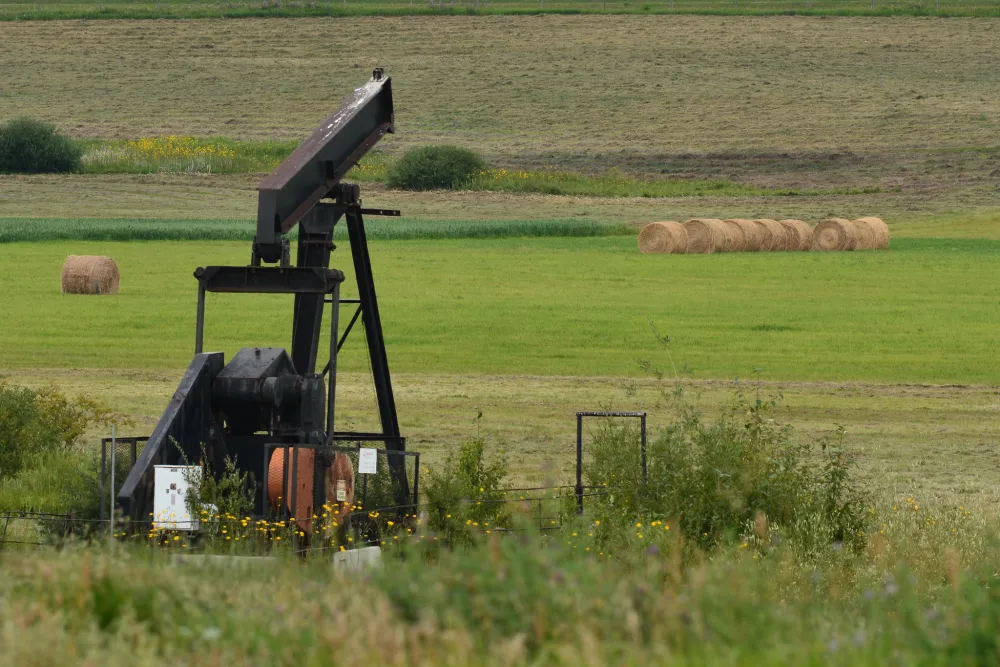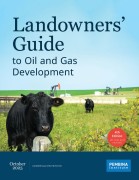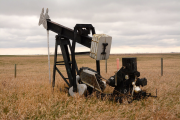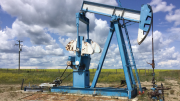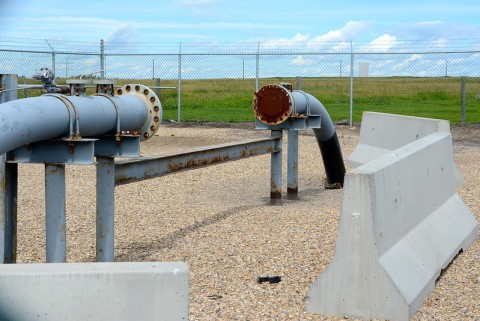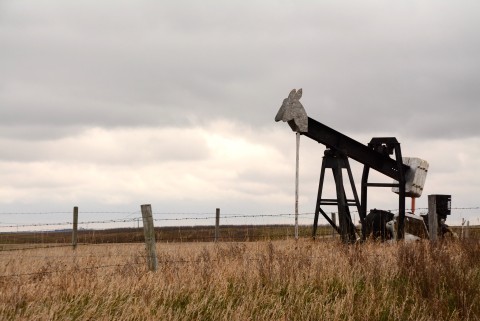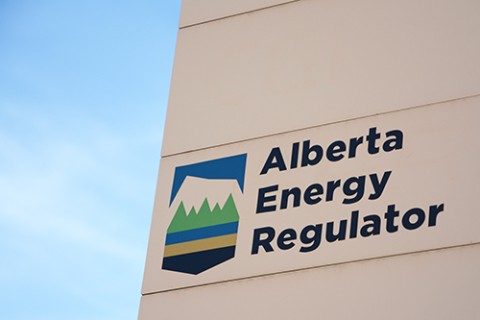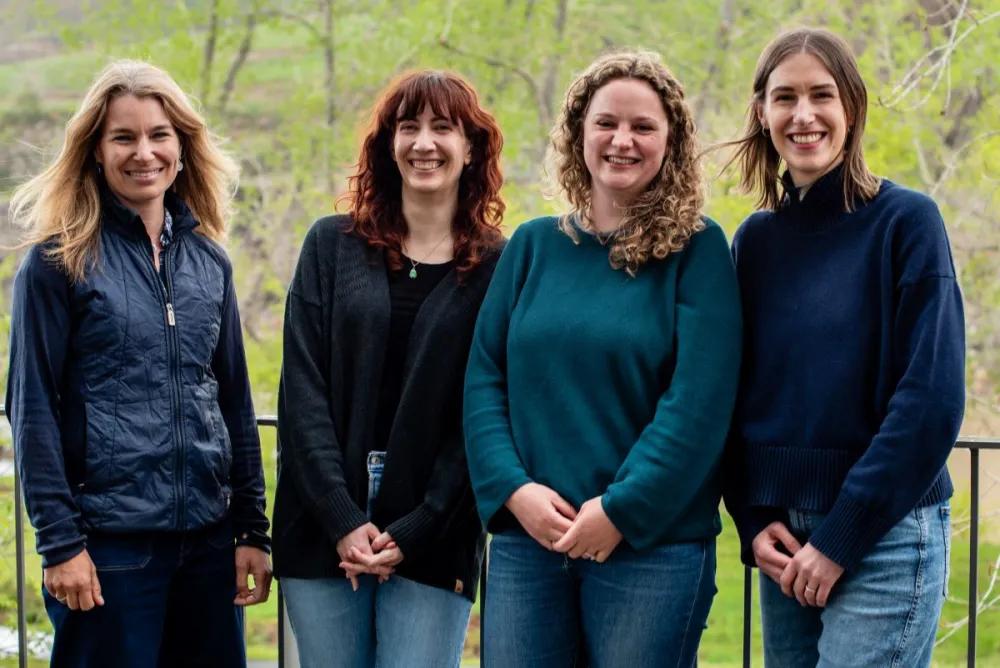Nov. 24, 2020 — Grant periods 5 and 6 of Site Rehabilitation Program
The Government of Alberta has announced Grant periods 5 and 6 of the Site Rehabilitation Program will open Feb. 1, 2021 and close the following year, on March 31, 2022.
For Grant period 5, $300 million in funding will be available to licensees that produced oil or gas in 2019 and spent corporate funds on abandonment and reclamation work in 2019 or 2020.
For Grant period 6, a total of $100 million will be available, with $85 million earmarked for First Nation Reserves and $15 million for Metis Settlements, to ensure well sites in Indigenous communities are properly abandoned and reclaimed. These communities will approve the sites, and work with licensees and contractors to approve spending. Once completed, they will inform the government as to which sites are eligible for funding, and how much funding should be made available.
For both Grant periods 5 and 6, projects are eligible for grants up to 50 per cent of costs, unless the contract is with an Indigenous oil field service company, in which case 100 per cent of costs can be recovered.
Sep. 10, 2020 — Orphan fund levy collection announced
After delaying collection of the annual orphan fund levy (see May 13, 2020), the AER has now issued a directive prescribing a levy of $65 million, with payment from licensees due Oct.15, 2020.
Aug. 7, 2020 — Grant period 4 of Site Rehabilitation Program
Grant period 4 of the Site Rehabilitation Program opened Aug. 7, 2020 and will close March 31, 2021, with another $100 million in funding available specifically to licensees who have submitted Area Based Closure (ABC) plans. Oil field service contractors must contract with qualified licensees, and only those contractors can apply for funding.
Up to 50 per cent of the cost of projects is eligible, with the exception of licensees engaging Indigenous oil field services companies, in which case up to 100 per cent of costs can be recovered. Landowners may see a boost to collaborative closure work in their region leading to faster and more efficient work, possibly seeing parts of the closure process expedited on their land.
July 30, 2020 — Liabilities Management Framework announced
Alberta has had a rapidly growing liabilities problem since the price downturn began in 2014. In early 2020, the UCP government stated it would complete a full review of how liabilities are managed in Alberta, initially expected to be completed in the first quarter of 2020. On July 30, 2020, the new Liabilities Management Framework was announced, which is intended to address the growing number of orphan and inactive wells.
The framework will include:
- Licensee Special Action: the Alberta Energy Regulator will provide guidance to oil and gas operators who are struggling financially and operationally, to help them maintain operations.
- Licensee Capability Assessment System: which will replace the current Licensee Liability Rate (LLR) system. The Alberta Energy Regulator will assess whether operators have the ability to operate profitably and abandon and reclaim all of their sites – which they are legally required to do – before obtaining regulatory approvals.
- Inventory Reduction Program: sets a target that companies need to spend on closing their oil and gas sites. The targets will be over a 5 year rolling period. Landowners will be able to nominate sites for this program.
- Addressing Legacy and Post-closure Sites: Brings together a panel of experts who are tasked with solving the problem of legacy and post-closure sites, or sites abandoned and reclaimed before current standards were put in place.
- Expanding the Mandate of the Orphan Well Association: the changes made under the Liabilities Management Statutes Amendment Act (Bill 12) are part of this new framework
This is a needed update to liabilities management, as the previous system allowed thousands of wells to become inactive or orphaned and did not provide landowners with proper support. However, this is early in the process, and the details of how this framework will actually be implemented have not been announced. Multiple directives will need to be updated in order to operationalize this new framework. Currently being updated is Directive 020: Well Abandonment, as well as Directive 067: Eligibility Requirements for Acquiring and Holding Energy Licences and Approvals.
July 17, 2020 — Grant period 3 of Site Rehabilitation Program
Grant period 3 of the Site Rehabilitation Program has opened and will close on March 31, 2021, with $100 million in funding available. Up to $139,000 will be available per license. In this phase, like all others, oil field services contractors must contract with licensees.
July 17, 2020 — Grant period 1B of Site Rehabilitation Program
Of the initial $200 million made available as part of Alberta’s Site Rehabilitation Program during grant periods 1 and 2, only $84 million was approved. Grant period 1B is meant to address this by re-examining declined application from the first two periods. No new applications are being accepted, only previously rejected ones.
June 26, 2020 — Responsible Energy Development Amendment Act comes into effect
Bill 7 received assent and came into effect as the Responsible Energy Development Amendment Act. (See May 27, 2020 post for more details)
May 27, 2020 — Bill 7 introduced (Responsible Energy Development Amendment Act)
Bill 7 — the Responsible Energy Development Amendment Act — was introduced in the Alberta Legislature. The bill allows the Government of Alberta to intervene in AER processes and establish time limits on energy project approval times. It also allows the government to establish time limits for any part of the approval process. This could potentially limit landowners’ and concerned parties’ ability to submit their concerns and have their voice heard due to restricted timeframes and sped up processes.
May 21, 2020 — Grant period 2 of Site Rehabilitation Program
Grant period 2 of Alberta’s Site Rehabilitation Program opened May 21, 2020, and closes June 18, 2020. This period makes $100 million available for sites on land where owners were no longer paying rents due to landowners. Applicants are able to apply for full closure of sites that fall under Section 36 of the Surface Rights Act, which deals with unpaid annual rentals, and landowners can nominate sites on their land.
May 13, 2020 — Delay of collection of orphan fund levy
The Alberta government has indefinitely delayed collection of the annual orphan fund levy from oil and gas companies, which would have totaled $65 million. During 2020, the OWA has received $200 million in additional funding from the federal government, which means that since 2017, the OWA has now received the majority of its funding from taxpayer dollars.
May 1, 2020 — Grant period 1 of Site Rehabilitation Program
Grant period 1 of Alberta’s Site Rehabilitation Program was launched, making $100 million of the $1 billion program available for oil and gas sites across Alberta to be properly abandoned and/or reclaimed. Landowners are able to nominate sites to be put onto a list for contractors to choose from. Contracts of up to $30,000 per application, per closure activity will be granted until May 15, 2020. While this is an important first step, there is a concern this is not enough money to clean up an individual site, as the AER estimates costs between $29,000 and $176,000 to plug and reclaim a site.
Apr. 24, 2020 — Site Rehabilitation Program announced
Alberta has announced the Site Rehabilitation Program, which will be used to administer the $1 billion in federal COVID-19 response funding (see April 17, 2020 post). The program provides grants to oil field service companies for abandonment and reclamation of oil and gas sites throughout Alberta. The funding will be made available through six phases, with application periods beginning May 1, 2020 through to March 31, 2022. Landowners will be able to nominate sites for clean up.
Apr. 17, 2020 — Federal funding for well clean-up announced
The federal government has announced $1.72 billion to clean up wells in B.C, Alberta and Saskatchewan as a part of COVID-19 relief. $200 million of this is an repayable loan to the Orphan Well Association (OWA), bringing the total loan amount to $535 million. Additionally, $1 billion is being allocated for cleaning up Albertan wells.
The money is meant to breathe life into Alberta’s struggling energy sector with the added bonus of cleaning up orphan and inactive wells throughout the province. The hope is to prevent them from falling into the orphan inventory if their owners become insolvent during this unpredictable time.
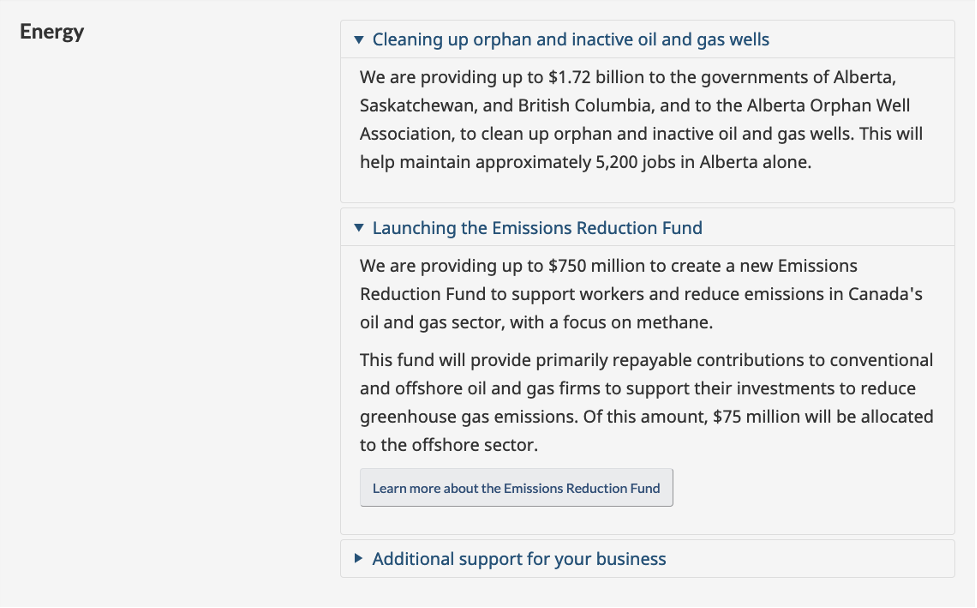
Screen capture from Government of Canada website, accessed April 2020.https://www.canada.ca/en/department-finance/economic-response-plan.html#industry (see Energy section)
Apr. 15, 2020 — OWA inventory updated
As of April 15, 2020, the OWA has an inventory of 2,983 orphan wells for abandonment and 3,284 sites for reclamation, according to the Government of Alberta. Many expect the inventory to grow as the effects of the COVID-19 pandemic and associated global market crash are felt.
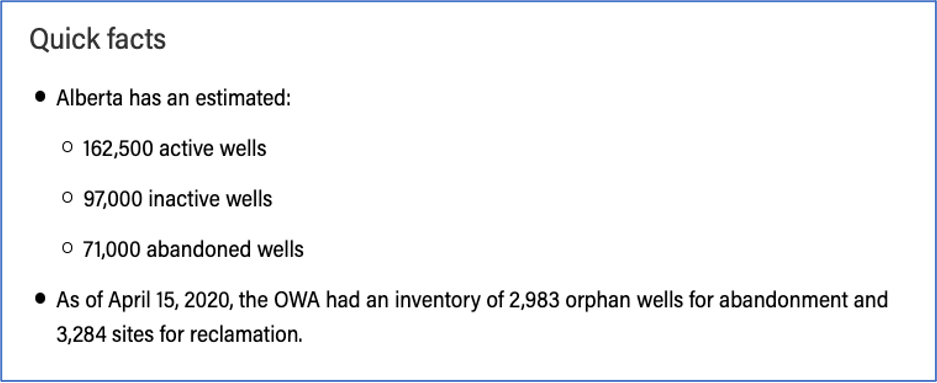
Screen capture from Government of Alberta website, accessed April 2020. https://www.alberta.ca/oil-and-gas-liabilities-management.aspx
Apr. 2, 2020 — Liabilities Management Statutes Amendment Act comes into effect
Bill 12 received assent and came into effect as the Liabilities Management Statutes Amendment Act. (See March 31, 2020 post for more details)
Mar. 31, 2020 — Bill 12 (Liabilities Management Statutes Amendment Act) introduced
Bill 12 — the Liabilities Management Statutes Amendment Act — was tabled in the Alberta Legislature. This bill expands the responsibilities for the OWA and allows the AER to apply to start the bankruptcy process for a company. This policy is important because it addresses concerns that the OWA did not have the power to manage wells that were still active in a safe way, or manage issues with remediation, reclamation, and abandonment. Better management of licenses from bankrupt companies will mean increased safety and efficiency of cleanup for landowners.
March 2020 — COVID impacts on liabilities
In March 2020, the first wave of COVID-19 hit Alberta and Canada. The government shifted attention away from policies such as those intended to assess liabilities in Canada. Further to this, as the global economy slowed, there is growing concern the decrease in oil demand will cause the Albertan oil industry to suffer, and lead to more orphan and inactive wells.
Feb. 27, 2020 — Loan extension for OWA
In February 2020, the Government of Alberta extended its loan to the OWA, adding $100 million to the previously announced loan to the organization, bringing the total loan to $335 million. This was announced in Budget 2020, under ‘A Blueprint for Jobs,' signaling the intention to create jobs by cleaning up liabilities and speed up the number of orphan wells being abandoned and reclaimed.
Jan. 20, 2020 — Survey finds oil and gas companies owe $173 million in municipal taxes
The Rural Municipalities Association of Alberta conducted a member survey and found that around $173 million in property taxes owed to municipalities by oil and gas companies. It was noted that rural communities have few options to recover unpaid property taxes from a bankrupted company.
This suggests the issue of insolvent oil and gas companies is having effects beyond landowners and now municipal coffers are coming up short — a shortfall that will likely be passed back to taxpayers, since municipalities are not legally allowed to run a deficit.
